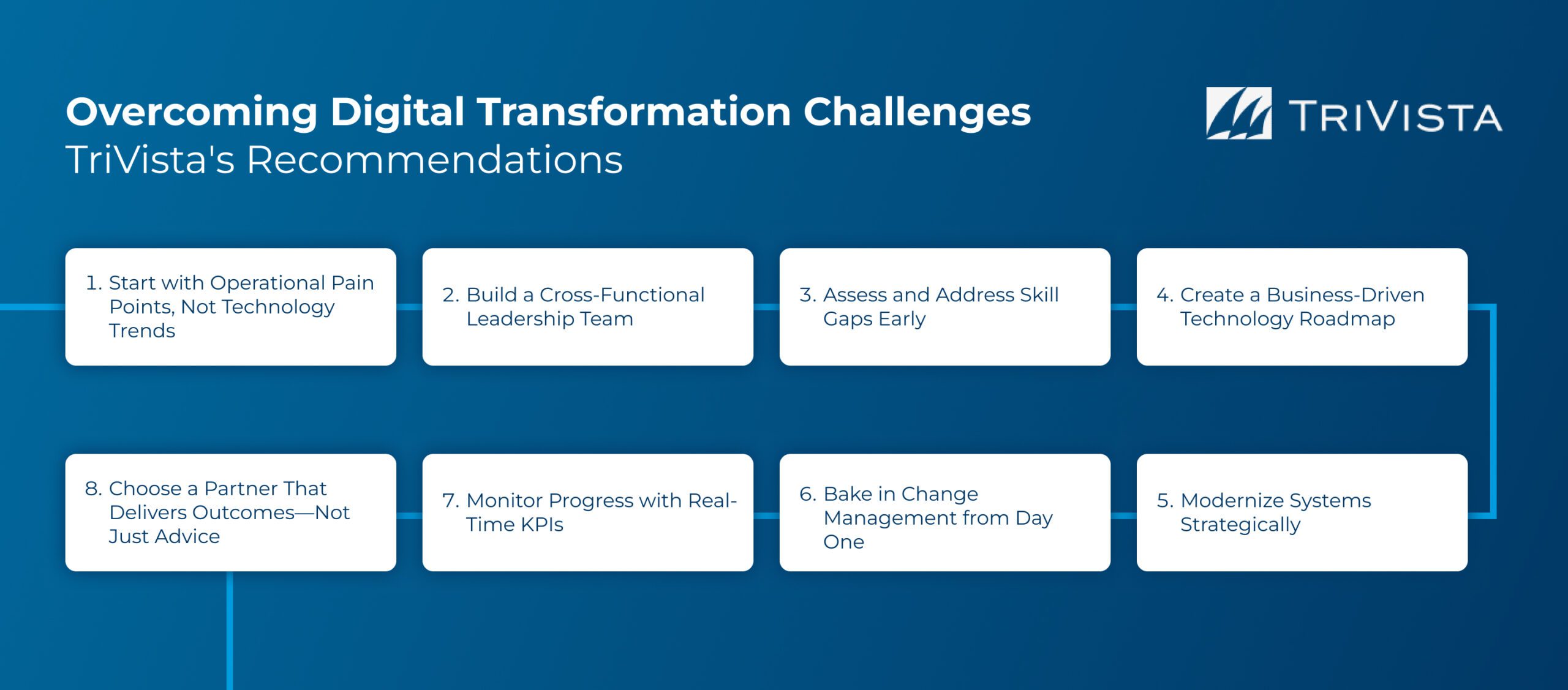Digital Transformation Challenges: Why Strategy Alone Isn’t Enough

True transformation requires more than a strategic roadmap—it demands executional excellence, operational alignment, and a deep understanding of how technology enables real business outcomes. Unfortunately, this is where many consulting firms fall short, offering abstract guidance without the means to implement it effectively.
At TriVista, we take a different approach. As former operators—not just career consultants—we’ve been in the trenches of digital transformation. We understand what it takes to turn strategy into action and ensure digital investments generate measurable results. In this data study, we explore the most common digital transformation challenges organizations face, how these obstacles impact business outcomes, and why execution is just as critical as strategy in driving long-term success.
The Business Impact of Digital Transformation
When executed effectively, digital transformation can serve as a powerful catalyst for business growth. From streamlining operations to unlocking new revenue channels, the impact of digital transformation on business extends well beyond the IT department. It can reshape entire business models, improve agility in volatile markets, and enhance decision-making through better data visibility.
Many organizations miss these opportunities by failing to connect technology initiatives to broader business goals. Instead of serving as a strategic enabler, digital transformation efforts often become siloed projects with limited impact.
Research shows that organizations that strategically align their digital transformation initiatives with clear business objectives experience nearly twice the success rate compared to those that don’t. Connecting digital investments directly to operational KPIs and value creation targets is essential for maximizing business impact and achieving sustainable results.
At TriVista, we help businesses avoid this pitfall by embedding digital transformation within the company’s value creation strategy. Whether it’s ERP modernization, post-M&A integration, or supply chain digitization, our work ensures that digital investments directly support financial performance—particularly EBITDA growth for private equity-backed companies.
Through structured KPIs and continuous alignment with operational objectives, we turn digital transformation from a theoretical goal into a business-critical asset. The result is not just improved technology infrastructure, but tangible business outcomes—faster time to value, increased productivity, and a scalable foundation for future growth.
Explore more: Digital Transformation Consulting Services

The Top 8 Digital Transformation Challenges
Despite the promise of digital transformation, organizations often encounter a complex set of roadblocks that delay progress, limit impact, or cause initiatives to fail altogether. Below are eight of the most critical challenges of digital transformation—along with how TriVista helps clients overcome them with action-oriented solutions.

1. The Digital Skill Gap
One of the most persistent challenges in digital transformation is the growing gap between technology capabilities and workforce readiness. As organizations implement advanced tools like ERP systems, AI-enabled analytics, and cloud infrastructure, many employees lack the necessary skills to leverage them effectively.
Without adequate digital fluency across the organization, adoption stalls and ROI diminishes. This challenge is particularly acute in mid-market firms that don’t have deep internal IT training resources.
How TriVista Helps:
We assess workforce capabilities early in the transformation process and identify skill gaps that could jeopardize success. Then we implement upskilling strategies that align with operational needs—not just IT goals. Our operator-led teams ensure change is grounded in real business workflows, not just technical theory.
2. Cultural Resistance to Change
Even the best digital strategies can fail when internal stakeholders resist change. Whether it’s fear of job displacement, attachment to legacy systems, or skepticism about new tools, cultural resistance can quietly undermine progress at every level of the organization.
Businesses that prioritize people and culture during change initiatives are 5x more likely to attain breakthrough performance compared to those that neglect the human element. This emphasizes the need for human-centered adoption strategies.
How TriVista Helps:
We take a proactive approach to change management by embedding culture-focused strategies within every transformation project. Our teams lead with empathy and credibility—because we’ve faced these same challenges as former operators. We also build leadership alignment and frontline engagement plans that accelerate adoption while minimizing disruption.
3. Legacy Systems & Technical Debt
Legacy infrastructure often presents significant barriers to transformation. From outdated ERP platforms to fragmented data environments, technical debt can make it difficult to integrate modern solutions or scale digital capabilities.
These legacy systems are not just slow—they’re incompatible with agile operations, increase security risk, and limit analytics potential.
How TriVista Helps:
We specialize in ERP modernization and post-M&A system integration, helping companies migrate from outdated systems without disrupting business continuity. Our approach blends IT due diligence with operational planning to ensure seamless transitions. We also address TSA (Transition Services Agreement) needs during carve-outs, helping clients establish IT independence with speed and precision.
4. Siloed Organizational Structures
Digital transformation requires cross-functional coordination—but many organizations operate in silos. When departments function independently without shared systems, goals, or workflows, it becomes difficult to roll out enterprise-wide digital initiatives.
Research shows that transformations with a dedicated cross-functional leadership team are 2.3 times more likely to succeed than those managed within a single department.
Capgemini also reports that only 39 percent of organizations say they’ve successfully scaled digital initiatives across business units, further underscoring the barrier posed by siloed structures (Capgemini, 2020).
How TriVista Helps:
We break down organizational silos by aligning digital strategy with the entire value stream. Through cross-functional workshops, business process mapping, and leadership engagement, we ensure technology investments support enterprise-wide collaboration—not just departmental needs. Our operational-first lens allows us to unify business functions under a shared digital vision.
5. Budget Constraints & Investment Alignment
Digital transformation is often seen as a cost center instead of a value driver. Without a clear ROI framework, organizations may struggle to secure funding or allocate resources effectively. Worse, investments may be made in the wrong places—prioritizing trendy tech over business-critical tools.
This misalignment between budget and strategic impact is one of the most overlooked challenges of digital transformation.
How TriVista Helps:
We tie every digital initiative directly to business outcomes, helping clients prioritize investments that deliver the greatest impact. By mapping transformation efforts to key performance indicators and investment theses—especially in private equity-backed environments—we ensure that capital is deployed where it matters most.
6. Security & Risk Management
As digital capabilities expand, so do cybersecurity threats. From cloud vulnerabilities to data privacy compliance, security concerns can slow down—or even derail—transformation initiatives. Many companies lack the internal controls or architecture needed to support a secure digital environment.
According to Accenture, 94% of executives report that technology adoption is outpacing their organization’s ability to manage risk and governance (Accenture, 2023).
This challenge is particularly critical during ERP upgrades, M&A integrations, and cloud migrations.
How TriVista Helps:
Our digital transformation strategy always includes a robust security component. We perform cybersecurity assessments, evaluate architecture risks, and ensure compliance protocols are in place before system changes occur. Our approach reduces exposure while maintaining business agility—so digital transformation doesn’t introduce new vulnerabilities.
7. Driving Adoption of New Tools & Processes
Implementing new digital tools is only half the battle—ensuring people actually use them effectively is where transformation succeeds or fails. Too often, companies roll out new platforms without addressing the workflows, training, and change management needed to ensure adoption.
When tools are underutilized or used inconsistently, the value of the investment plummets and productivity suffers.
How TriVista Helps:
We prioritize adoption from day one, integrating training, communication, and user engagement strategies into the overall transformation plan. Our teams don’t just deliver the system—we help build the routines, processes, and accountability structures that drive sustained adoption. Because we’ve led teams ourselves, we understand how to turn technology into a habit.
8. Measuring ROI and Business Alignment
Digital transformation initiatives often stall because leadership can’t clearly see the return on investment. Without defined KPIs and ongoing alignment with business objectives, digital projects can become disconnected from financial performance—causing support and momentum to fade.
Tracking ROI isn’t just a reporting function—it’s essential to maintaining strategic focus and justifying future investments.
How TriVista Helps:
We embed performance measurement frameworks into every transformation effort. Our approach includes establishing baseline metrics, defining business-aligned KPIs, and tracking performance through regular check-ins. We ensure every step of the journey supports broader business goals—particularly EBITDA growth and value creation for private equity stakeholders.
TriVista’s Action-Based Approach: Bridging Strategy and Execution
At TriVista, we believe the success of any digital transformation lies not just in the strategy, but in the execution. While many firms focus on high-level planning and theoretical frameworks, we focus on delivering measurable results—through a hands-on, action-based approach that turns ideas into outcomes.
What sets us apart is our operator-first model. Our team is made up of former industry leaders who have firsthand experience navigating digital transformation from the inside. We’ve managed complex ERP implementations, integrated IT systems post-acquisition, and led business units through cultural change—not from a PowerPoint deck, but from the shop floor, the boardroom, and the front lines of execution.
Our methodologies are structured yet flexible. We use proven tools and proprietary templates to maintain rigor while adapting to each client’s specific business context. Unlike traditional consultants, we don’t walk away once the strategy is written—we stay involved, providing oversight and guidance to ensure the plan is followed through to real business impact.
Key elements of TriVista’s approach include:
- Business-first transformation strategy: We begin with a deep understanding of business pain points and value drivers—not just technology preferences.
- Cross-functional alignment: Our transformation plans bridge operations, IT, and executive leadership to ensure all stakeholders are moving toward shared goals.
- Operator-led execution: Our teams support implementation by bringing real-world leadership and credibility to drive adoption and accountability.
- Integrated KPI tracking: We embed success metrics and business impact tracking from day one, so progress is visible and value creation is measurable.
- Strategic partner—not a systems integrator: We guide clients through vendor selection and implementation oversight, but remain focused on value creation rather than software configuration alone.
Digital transformation is complex—but with TriVista, clients gain a partner that understands both strategy and the gritty reality of execution. We don’t just recommend change—we help make it happen.
Case Study Snapshot — Real Impact in Action
To illustrate how TriVista brings strategy to life, let’s look at a real-world example of digital transformation done right. This case highlights the importance of execution-focused consulting, especially when managing complex ERP transitions within tight timelines.
Client Challenge: Navigating ERP Modernization During a Carve-Out
A private equity firm engaged TriVista to support a portfolio company undergoing a carve-out from a larger parent organization. The goal was to rapidly establish IT independence and implement a new ERP system that would align with the business’s operational needs and future growth plans.
However, the carve-out came with a looming Transition Services Agreement (TSA) deadline, legacy system dependencies, and fragmented business processes that had been shaped by the former parent company’s structure. A traditional consulting approach would have led to delays, misalignment, and cost overruns.
TriVista’s Approach: Action Over Abstraction
Our team conducted a Technology Rapid Assessment to identify gaps in the current IT infrastructure and business workflows. Using our proprietary tools, we mapped the organization’s operational needs to system requirements and conducted an expedited ERP selection process—ensuring the new platform would scale with the company’s growth trajectory.
TriVista also took on implementation oversight, guiding the client through data migration, change management, and post-go-live stabilization. Because our consultants were former operators, we could anticipate roadblocks and proactively address them before they impacted timelines or productivity.
Results Delivered:
- ERP system selected and implementation partner engaged in under 10 weeks
- Successful go-live within TSA deadlines, avoiding penalties and business disruption
- Improved process visibility and real-time data access across departments
- Seamless integration with operational workflows and leadership KPIs
- Foundation established for scalable growth and future system enhancements
This project demonstrates how TriVista’s execution-first approach enables companies to not only complete digital transformations on time and within budget—but also align those efforts with long-term business value.
See the full case study: ERP Assessment Case Study
Overcoming Digital Transformation Challenges – TriVista’s Recommendations
While digital transformation challenges are complex, they aren’t insurmountable. At TriVista, we believe that with the right strategy, structure, and execution discipline, organizations can overcome these barriers and unlock the full value of their digital initiatives. Below are actionable recommendations based on our deep experience guiding mid-market companies through successful transformation journeys.

1. Start with Operational Pain Points, Not Technology Trends
Many companies begin digital transformation by chasing the newest technologies—but this often leads to misaligned solutions. Instead, start by identifying operational inefficiencies, supply chain bottlenecks, and value stream opportunities. Your digital strategy should solve real business problems, not just adopt flashy tools.
2. Build a Cross-Functional Leadership Team
Digital transformation must be owned by more than just the CIO. Form a cross-functional leadership team that includes operations, finance, supply chain, and commercial leaders. This ensures alignment across business units and keeps transformation initiatives focused on enterprise-wide outcomes.
3. Assess and Address Skill Gaps Early
Conduct a digital readiness assessment early in the project lifecycle to identify workforce capability gaps. Then implement targeted training programs and user onboarding strategies to ensure adoption and minimize resistance.
4. Create a Business-Driven Technology Roadmap
Map each digital initiative to a specific business goal or KPI—whether it’s reducing lead time, improving on-time delivery, or enhancing margin performance. This ensures investment alignment and makes it easier to measure ROI throughout the transformation.
5. Modernize Systems Strategically
When addressing legacy systems, don’t default to rip-and-replace. Evaluate integration paths, TSA requirements, and scalability factors. In many cases, strategic modernization—guided by operator-level insight—can yield faster ROI and lower risk than full system overhauls.
6. Bake in Change Management from Day One
Adoption doesn’t happen organically. Build change management into the core of your project, including employee engagement, training, communication, and performance feedback loops. The goal is not just system usage—but cultural adoption.
7. Monitor Progress with Real-Time KPIs
Develop dashboards and reporting tools to track progress against business-aligned KPIs. This keeps leadership informed, flags risks early, and reinforces accountability across teams.
8. Choose a Partner That Delivers Outcomes—Not Just Advice
Finally, transformation success hinges on who’s guiding the effort. Many firms offer strategic guidance but lack the experience to drive execution. TriVista’s operator-led teams bring industry-tested judgment and practical oversight to ensure that digital investments yield real business value.
Learn more about how we help: Technology Strategy & Advisory Services
Conclusion
Digital transformation is no longer a choice—it’s a competitive necessity. But too often, companies underestimate the complexity involved and fall short of achieving their goals. From skill gaps and siloed structures to legacy systems and misaligned investments, the challenges of digital transformation are real—and they can’t be solved by strategy alone.
Success requires action. It requires leadership that understands not only what needs to change, but how to make that change stick. And it requires a partner who has walked in your shoes—one who can align technology with business outcomes and turn roadmaps into measurable results.
At TriVista, we do more than consult. We execute. Our operator-led teams bring real-world expertise, proven methodologies, and business-first thinking to every engagement—ensuring your transformation delivers not just change, but lasting value.
Ready to move beyond strategy and into results? Explore our Digital Transformation Consulting Services or Contact Us to speak with a transformation expert today.
References
Accenture – Technology Vision 2023
https://www.accenture.com/us-en/insights/technology/technology-trends-2023
Capgemini – Digital Mastery Report (2020)
https://www.capgemini.com/news/press-releases/digital-mastery-2020-report/
Contact Us
Please contact us if you have any questions. We are happy to put you in touch with the subject matter expert in your field.
Contact Us Form
Contact Us page on TriVista.com
